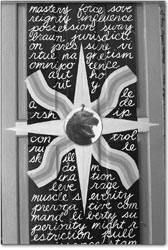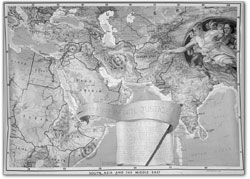|
|
||||||
|
Art and politics
by Jules Masterjohn Political art … what is it? An artwork can be considered political if it offers a perspective on social relationships. I believe this artistic genre is all about identifying power and its associations. Maureen May, a prolific and diversely talented local artist, has created a body of work that specifically addresses these issues. Her interest in power relationships was first evidenced in the 1998 series, “Portraits of Survivors of Domestic Abuse.” In this series, the personal is the political and the survivors’ portraits are about more than the usual externalized “power over.” This series is intrinsically about empowerment, the acknowledgement and cultivation of the “power within.” Years have passed since she created the survivors’ series, and today, though still very personal, May’s art is overtly political as well. From her mixed-media works “Sifting Through the Black & White” and “No Matthew 5:9 (The Geography Lesson),” to the functional sculptures “Power Chair” and “Desperate Measures Create Desperate Times,” May’s art challenges and confronts with clear concept, seductive aesthetics and skillful implementation. Her decision to make work that critiques the status quo began during the Bush/Gore campaign. During this time, May said her “mind really started going wacko with all sorts of ideas” that related to the 2000 election, vote counts and the following Supreme Court decision. Though this was compelling subject matter, it proved to be the events of Sept. 11, 2001, that spurred her to act. Within a few weeks of the 9-11 attacks, May began work on a number of pieces that were inspired by the government’s responses and the U.S. media coverage. “I felt that I wasn’t getting enough of the story, was getting contradictory information and only the basic facts. I wanted more details and wasn’t getting it.” As artists will do, May engaged her creative process to help her understand, document and share what she was experiencing. “Sifting Through the Black & White,” a pile of more than 3,000 puzzle pieces that “don’t all fit together,” is a visual metaphor for the fragmented, confusing and disorganized news coverage that May encountered and is visually related to the rubble pile from the collapsed World Trade Center towers. Puzzle pieces are covered with either text or images from stories in the print media related to the event. “The Bush administration and the media had reduced things to black and white, and I started seeing a real divisive feeling in people … either this is right or that is right. This piece was my response to try and make sense of the substance of what happened.”
the rubble pile from the collapsed World Trade Center towers. Puzzle pieces are covered with either text or images from stories in the print media related to the event. “The Bush administration and the media had reduced things to black and white, and I started seeing a real divisive feeling in people … either this is right or that is right. This piece was my response to try and make sense of the substance of what happened.” Next, May tackled the discrepancies she found between what the U.S. corporate media sources were printing and what she was reading from news sources in other countries. “Getting Back to My Normal Day-to-Day Business,” a mixed-media piece, combines individually mounted documentary photographs, one for each day of November, with headlines from the world news media. May explains, “With this piece I was sick and tired of hearing Bush and his cronies telling us to get back to our day-to-day business, to just do what we normally do. I wanted to do a month of personal portraits and headlines to show the contrast between our daily business in this country as opposed to what was going on around the world, with stepped-up security, retaliation, the bombing of Afghanistan and civil rights violations around the world.” Researching articles from many different country’s newspapers helped May open up her understanding of what 9-11 meant to people the world over and to interpret her daily experience within a broader context. This world view is a grounding reality for her personal experience and is visually articulated by the headlines collaged onto the bases that hold the photographs. At the same time, May was working on “Desperate Measures Create Desperate Times,” an audience participatory piece. May purchased an old soda vending machine and converted it into an art dispenser. She invited several local artists to create small works that would fit inside a soda can, to be dispensed from the machine for $1. She plastered the outside with slogans, both pro and anti-war, in response to the U.S. governments attack on Afghanistan. Perhaps May’s most impressive piece in this body of politically inspired work is her mixed-media painting, “No Matthew 5:9 (The Geography Lesson).” Painted on a large wall map of the Middle East is a group portrait of President Bush surrounded by his closest advisors, rendered to mimic the style and composition of Michelangelo’s “The Creation of Adam” from the Sistine Chapel. The central Bush figure extends his arm and points his index finger toward Afghanistan in a pose reminiscent of the God portrait in the Michelangelo painting. The idea for the piece came to May in a flash when she heard that the U.S. would be invading Afghanistan. She recalled, “Within moments of hearing that the operation was to be called ‘Infinite Justice,’ I got the idea for this piece. ‘Bush just declared himself God,’ I said to myself.” Her initial concept portrayed Bush with his finger touching Kabul and setting it aflame, however the piece took longer to complete than she anticipated. By the time she finished it the U.S. had also invaded Iraq. “I wondered how I was going to include Iraq, and I decided on laser beams coming from Bush’s eyes going to Iraq, which was a suggestion from my husband, Paul.” Last year, May created the whimsical yet serious “Power Chair” for the KDUR Furniture as Art auction. “I mainly made the piece because I feel that there is too much power being thrown around without understanding or caring about the consequences.” The intricately painted throne, equipped with a removable scepter and interchangeable “power” symbols, invites viewers to sit and experience the phases and faces of power. “I made this piece to show how strong, controlling and freeing power could be.” With power still running amuck within the human community, May should have inspiration for a very long time. Imbued with intelligence and insight, we can look forward to future pieces by May that deal with ethnic profiling, the endangerment of our civil liberties and the current role of religion in U.S. society. May reflected, “Fifteen or 20 years ago, I never would have dreamed my art would have taken this direction. But I guess that’s what artists do … they stay open to the world around and within them and let their creativity respond naturally. It’s empowering.” Maureen May’s work can be viewed at www.artistsregister.com.
|




